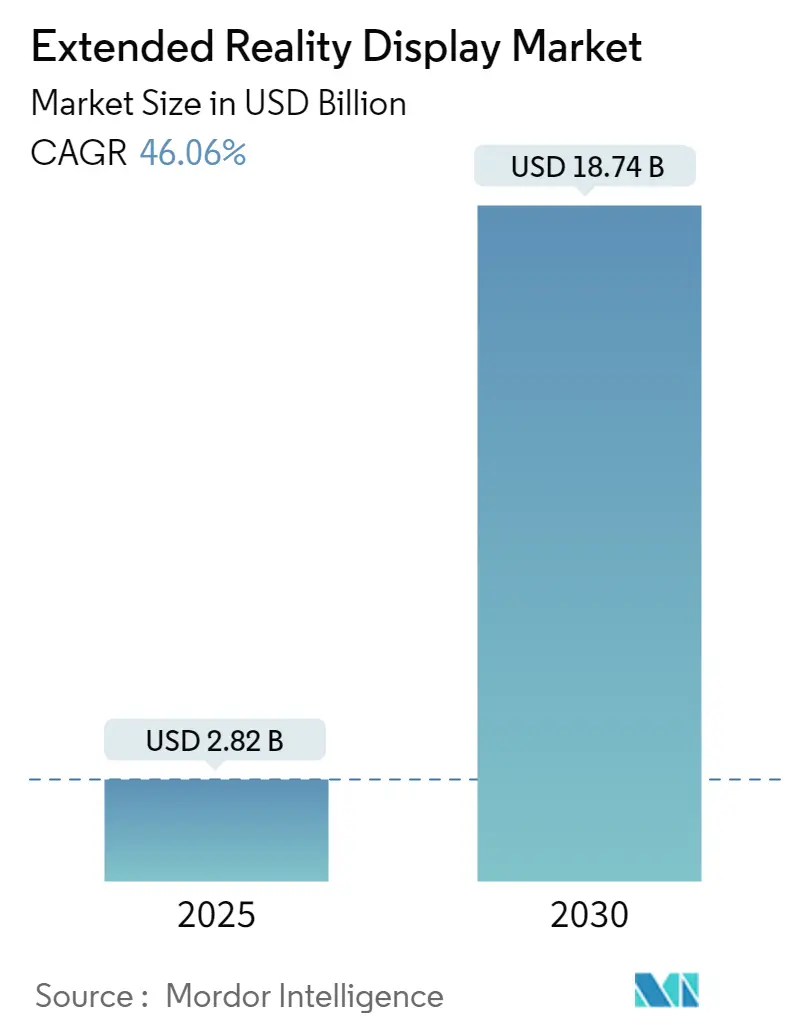
| Study Period | 2019 - 2030 |
| Market Size (2025) | USD 2.82 Billion |
| Market Size (2030) | USD 18.74 Billion |
| CAGR (2025 - 2030) | 46.06 % |
| Fastest Growing Market | Asia Pacific |
| Largest Market | North America |
| Market Concentration | Low |
Major Players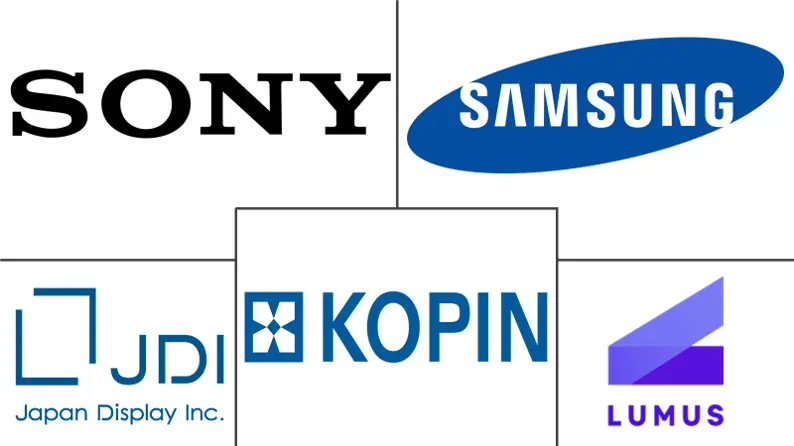
*Disclaimer: Major Players sorted in no particular order |
Extended Reality Display Market Analysis
The Extended Reality Display Market size is estimated at USD 2.82 billion in 2025, and is expected to reach USD 18.74 billion by 2030, at a CAGR of 46.06% during the forecast period (2025-2030).
The extended reality display industry is undergoing a fundamental transformation as technologies converge and use cases expand beyond gaming and entertainment. The integration of 5G networks is proving to be a crucial enabler for XR display applications, with an Ericsson mobility report indicating that nine in ten mobile subscriptions in North America are expected to be 5G by 2027. This technological convergence is enabling more seamless and immersive experiences across connected devices, while advances in immersive display technology are addressing previous limitations around resolution, field of view, and user comfort. The industry is witnessing a shift from traditional displays to more sophisticated solutions incorporating micro-LED and OLED technologies, enabling thinner, lighter, and more power-efficient devices.
Enterprise adoption of XR displays is accelerating across various sectors, driven by the need for more effective training and collaboration tools. According to the World Economic Forum projections, over one billion workers will need reskilling by 2030, creating significant opportunities for XR-based training solutions. Major corporations are increasingly integrating XR displays into their operations, with an Accenture survey revealing that over 90% of executives believe their existing training methods must become more effective and efficient. This trend is particularly evident in industries such as manufacturing, healthcare, and retail, where XR displays are being used for everything from surgical training to virtual product demonstrations.
The display technology landscape is experiencing rapid innovation, with manufacturers focusing on developing next-generation solutions. Meta unveiled four virtual reality prototype VR displays in 2023, addressing challenges related to resolution, visual distortion, and eye fatigue. Similarly, Apple's development of mixed reality headsets incorporating multiple display technologies signals a growing emphasis on visual quality and user experience. These innovations are pushing the boundaries of what's possible in terms of display performance, with companies investing heavily in technologies like micro-OLED and advanced optics to deliver more realistic and comfortable viewing experiences.
The retail sector is witnessing a significant transformation in how XR displays are being integrated into the shopping experience, with the National Retail Federation reporting that 72% of US retail sales are still expected to occur in brick-and-mortar stores in 2024. This has led to innovative applications of AR displays in physical retail spaces, such as Samsung's AR shopping experience and Meta's first physical store showcasing metaverse display-related products. The automotive industry is also embracing XR display technology, as evidenced by Microsoft and Volkswagen's collaboration on the Moving Platform project, which enables accurate AR displays in moving vehicles. These developments demonstrate the versatility of XR displays and their potential to transform traditional industries through enhanced visualization and interaction capabilities.
Extended Reality Display Market Trends
Rising Adoption of AR and VR Applications Across Multiple End-User Industries
The extended reality (XR) display market is experiencing significant growth driven by widespread adoption across diverse industry verticals, including gaming, healthcare, education, and military applications. In the gaming sector, companies are continuously innovating their products with advanced features like hand tracking and gesture-based computing, enabling users to manipulate virtual environments more intuitively. For instance, major developments include Meta's unveiling of four new virtual reality display prototypes in 2023, focusing on delivering enhanced visual experiences while addressing challenges like poor resolution and eye fatigue. The automotive industry has also embraced XR technology, with companies like Audi implementing augmented reality display systems that synchronize with vehicle movements to provide immersive experiences for passengers.
The healthcare and education sectors are witnessing transformative applications of XR displays, with over 68% of healthcare organizations implementing training simulations for medical procedures and surgical training. According to recent industry surveys, more than 90% of executives acknowledge the need for more effective training methods, driving the adoption of XR-based solutions. In the education sector, institutions are increasingly incorporating AR and VR-based training programs, as evidenced by partnerships like the University of East London's EON-XR Center initiative, which provides students and faculty access to comprehensive AR/VR training through various devices. The military and defense sector has also recognized the potential of XR displays, with organizations like the Foreign Service Institute implementing VR as an experiential learning tool for specific training programs.
Significant Technological Advancement Across Micro-displays Such as MicroLEDs
The extended reality display market is witnessing revolutionary technological advancements, particularly in microdisplay technologies like MicroLEDs, which are transforming the visual experience in XR devices. Major display manufacturers are investing heavily in research and development to overcome traditional limitations of display technologies. For instance, Samsung's recent developments in MicroLED technology have demonstrated significant improvements in brightness levels, achieving millions of levels of contrast while maintaining power efficiency. These advancements are particularly crucial for professional reality displays, automotive displays, and high-end consumer display products, where image quality and performance are paramount.
The industry is experiencing a shift toward more sophisticated display technologies, with companies like BOE Technology Group developing Mini/Micro LCD displays that offer enhanced brightness and resolution capabilities. These technological improvements are enabling new applications across various sectors, from professional design to automotive displays. Additionally, manufacturers are focusing on addressing key challenges such as peak brightness, lifetime, and power consumption through innovations in display technology. For example, Japan Display Inc. (JDI) has developed revolutionary transparent display technology and is working on advanced solutions like Poly-OS, a novel poly-crystalline oxide semiconductor for various displays, including wearable devices and metaverse applications. These technological advancements are creating new possibilities for XR applications while improving user experience through better visual quality and reduced form factors.
Segment Analysis: By Display Type
OLED Segment in Extended Reality Display Market
The Organic Light Emitting Diode (OLED) segment dominates the Extended Reality Display Market, commanding approximately 58% market share in 2024, establishing itself as the cornerstone of XR display technology. This dominance can be attributed to OLED's superior performance characteristics, including higher contrast ratios, faster response times, and better black levels compared to alternative technologies. The segment's leadership is further strengthened by major manufacturers like Samsung Display and LG Display investing heavily in OLED production capabilities for XR applications. OLED displays are particularly favored in virtual reality headsets and augmented reality glasses due to their simplified design, enhanced image quality, and potential for flexibility. The technology's ability to operate without backlighting, enabling thinner and more moldable screens, has made it increasingly attractive for next-generation XR devices. Additionally, the emergence of micro-OLED technology, which offers higher pixel density and improved power efficiency, has further solidified OLED's position as the preferred choice for premium XR display applications, contributing significantly to the microdisplay market.
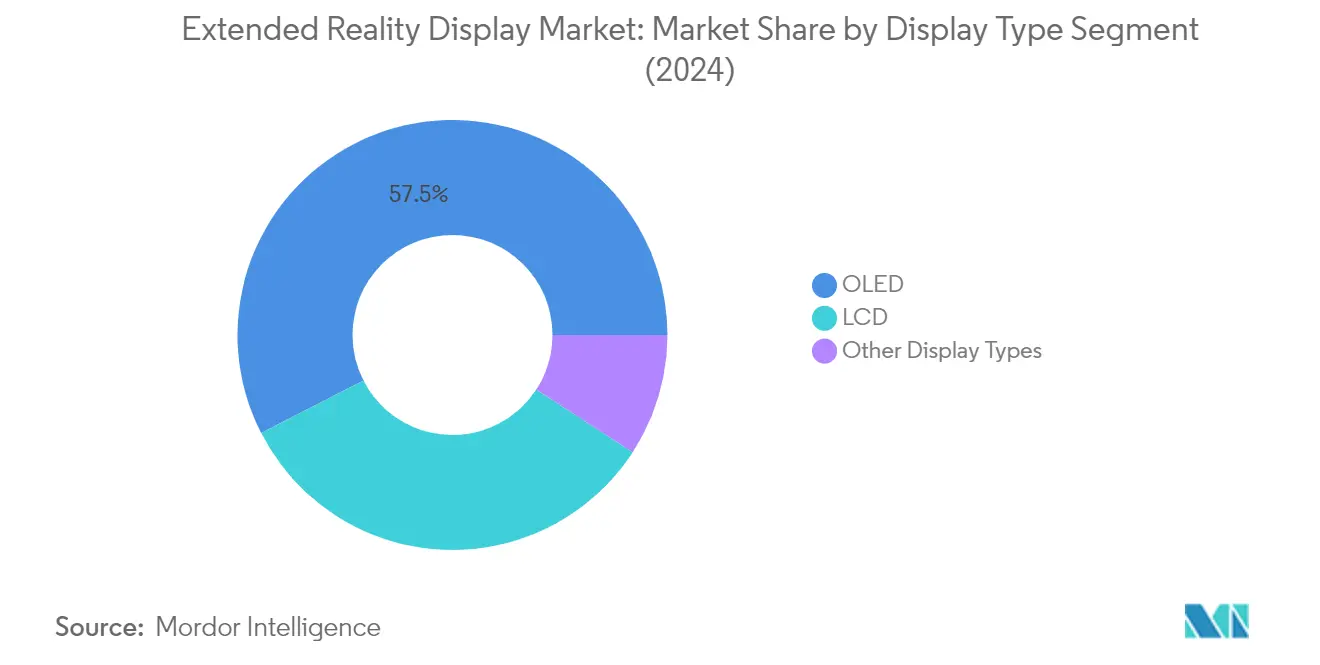
LCD Segment in Extended Reality Display Market
The Liquid Crystal Display (LCD) segment continues to maintain a significant presence in the Extended Reality Display Market, particularly in applications where cost-effectiveness is a priority. LCD technology benefits from its mature manufacturing processes and established supply chains, making it an attractive option for mass-market XR devices. The technology has evolved to address previous limitations, with the introduction of fast-switch LCD panels improving response times and reducing motion blur in VR applications. Many popular VR headsets continue to utilize LCD panels due to their ability to achieve high pixel densities above 1000 PPI, which is crucial for delivering sharp, clear images in near-eye displays. The technology's ongoing improvements in areas such as high-dynamic-range (HDR) and mini-LED backlighting have also enhanced image quality while reducing power consumption, making it a viable option for various XR applications. Moreover, the integration of transparent display technology is enhancing the versatility of LCDs in the interactive display market.
Remaining Segments in Display Type
Other display technologies in the Extended Reality Display Market include emerging solutions such as LCoS (Liquid Crystal on Silicon), DLP (Digital Light Processing), and Micro LED displays. These technologies offer unique advantages for specific XR applications, with Micro LED particularly showing promise due to its potential for higher brightness, enhanced durability, and longer lifespan compared to traditional display technologies. The development of these alternative display technologies is driving innovation in the XR space, providing manufacturers with more options to address specific use-case requirements. These emerging technologies are particularly relevant for specialized applications in enterprise, military, and high-end consumer markets where specific performance characteristics are prioritized over cost considerations. The holographic display industry and wearable display industry are also exploring these technologies for advanced applications.
Segment Analysis: End-User Industry
Gaming and Entertainment Segment in Extended Reality Display Market
The Gaming and Entertainment segment dominates the Extended Reality Display market, commanding approximately 45% market share in 2024, driven by the increasing adoption of XR technologies in gaming applications and immersive entertainment experiences. The segment's prominence is reinforced by major gaming companies investing heavily in metaverse development, with virtually every major gaming company from Sony to Microsoft actively expanding their XR capabilities. The demand is particularly strong in the gaming sector where XR displays are being utilized for creating more memorable, immersive, and engaging experiences for users. Samsung's pursuit of multi-device connectivity and Meta's continuous innovation in VR technology have further strengthened this segment's position. The segment's growth is also supported by the rising trend of virtual concerts, immersive gaming experiences, and the integration of XR technologies in theme parks and entertainment venues. Additionally, the segment benefits from the increasing consumer preference for high-quality display technologies in gaming devices, particularly OLED and advanced LCD displays that offer superior visual experiences, aligning with the advancements in the mixed reality display sector.
Healthcare Segment in Extended Reality Display Market
The Healthcare segment is emerging as a transformative force in the Extended Reality Display market, with a projected growth rate of approximately 46% during 2024-2029. This remarkable growth is driven by the increasing adoption of XR technologies in medical training, surgical planning, and patient care applications. Healthcare professionals are increasingly utilizing XR displays for simulated surgical training, palliative hospice care, pain management, and 3D visualization of diseases at the molecular level. The segment's growth is further accelerated by the development of extended medical reality (MXR) devices, which are being successfully implemented in clinical settings and hospitals. The integration of XR technology in medical education and training programs is creating new opportunities for realistic simulation-based learning. Additionally, the adoption of XR displays in telemedicine applications and remote patient monitoring is expected to drive significant growth in this segment, particularly as healthcare providers continue to embrace digital transformation and virtual care delivery models.
Remaining Segments in End-User Industry
The Extended Reality Display market encompasses several other significant segments including Education, Military and Defense, Automotive and Manufacturing, and Retail, each contributing uniquely to the market's dynamics. The Education segment is revolutionizing learning experiences through immersive technology applications in both academic and professional training environments. The Military and Defense sector utilizes XR displays for combat training, simulation exercises, and tactical operations planning. The Automotive and Manufacturing segment is leveraging XR displays for design visualization, assembly training, and maintenance procedures. The Retail sector is transforming shopping experiences through virtual try-ons and immersive product demonstrations. These segments collectively demonstrate the versatility and broad applicability of XR display technology across different industries, each driving innovation and adoption in their respective domains.
Extended Reality Display Market Geography Segment Analysis
Extended Reality Display Market in North America
North America continues to dominate the extended reality display market, holding approximately 66% of the global market share in 2024. The region's leadership position is driven by substantial investments in research and development from major technology companies and strong government support for XR technologies. The presence of key industry players and a robust ecosystem of startups has created a fertile ground for innovation in display technologies, including the wearable display market. The region's advanced technological infrastructure, coupled with high consumer awareness and adoption rates of AR/VR devices, has contributed to market growth. The healthcare, military, and gaming sectors have emerged as primary drivers for XR display adoption, with increasing applications in medical training, military simulations, and immersive gaming experiences. The integration of 5G technology and continuous advancements in display resolution and performance have further accelerated market expansion. Additionally, the region's strong focus on enterprise applications and professional training solutions has created sustained demand for high-quality XR displays, including immersive display technologies.
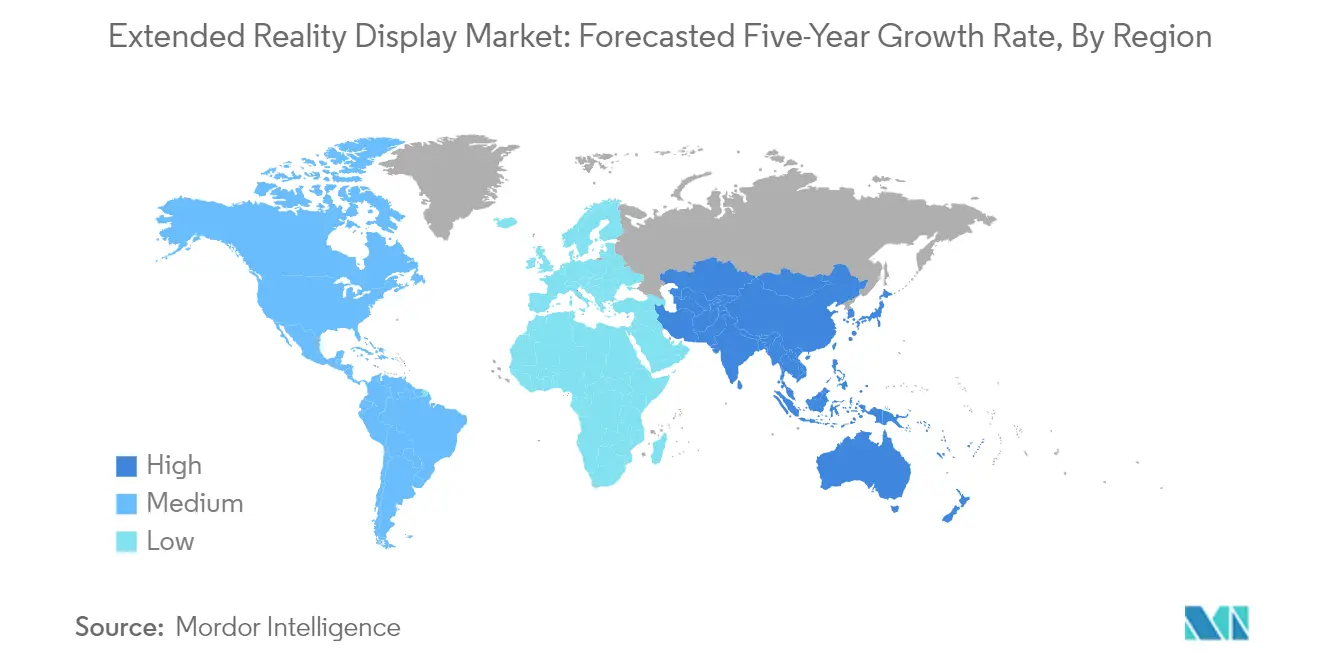
Extended Reality Display Market in Europe
The European extended reality display market has demonstrated robust growth, with an approximate growth rate of 40% between 2019 and 2024. The market's expansion is primarily driven by increasing adoption across multiple industries, particularly in manufacturing, automotive, and healthcare sectors. European companies have been at the forefront of developing innovative XR solutions for industrial applications, with particular emphasis on training and simulation. The region's strong focus on Industry 4.0 initiatives has accelerated the integration of XR technologies in manufacturing processes, including the holographic display market. The presence of established automotive manufacturers and their increasing investment in AR-based design and maintenance applications has created sustained demand for XR displays. The European Union's supportive regulatory framework and funding initiatives for digital transformation have provided additional momentum to market growth. The region has also witnessed significant developments in display technology research, particularly in micro-LED and OLED technologies, supported by collaboration between academic institutions and industry players.
Extended Reality Display Market in Asia-Pacific
The Asia-Pacific region represents the fastest-growing market for extended reality displays, with a projected growth rate of approximately 48% from 2024 to 2029. The region's market dynamics are shaped by rapid technological advancement and increasing manufacturing capabilities, particularly in countries like China, South Korea, and Japan. These nations have established themselves as key players in display technology manufacturing, with significant investments in production facilities for OLED and micro-LED displays, contributing to the 3D display sector. The presence of major display manufacturers and their continuous innovation in display technology has created a robust supply chain ecosystem. The region's large consumer base and increasing disposable income have driven demand for XR devices across gaming and entertainment applications. The industrial sector's digital transformation initiatives and growing adoption of AR/VR technologies in educational institutions have created additional growth opportunities. Government support for digital initiatives and smart city projects has further accelerated the adoption of XR technologies across various applications, including the transparent display market.
Extended Reality Display Market in Rest of the World
The Rest of the World region, encompassing the Middle East, Africa, and Latin America, represents an emerging market for extended reality displays with significant growth potential. These regions are witnessing increasing adoption of XR technologies across various sectors, particularly in education, healthcare, and retail. The Middle East has shown particular interest in implementing XR solutions for tourism and retail applications, leveraging the technology to enhance customer experiences. Latin American countries are gradually embracing XR technologies in educational institutions and industrial training applications. The region's growing focus on digital transformation and increasing investment in technological infrastructure are creating new opportunities for XR display manufacturers. While adoption rates currently lag behind other regions, increasing awareness of XR benefits and growing investment in digital infrastructure are expected to drive future growth. The region's diverse industrial base and expanding educational sector present significant opportunities for XR display applications, including optical display and wearable display market solutions.
Extended Reality Display Industry Overview
Top Companies in Extended Reality Display Market
The extended reality display market features established electronics giants like Samsung, Sony, and LG Display alongside specialized players such as Kopin Corporation, eMagin, and Lumus. These companies are driving innovation through significant investments in micro-OLED and microdisplay technologies to enhance display resolution and reduce form factors. Strategic partnerships with technology companies and defense contractors have become increasingly common to accelerate product development and market penetration. Companies are expanding their manufacturing capabilities while simultaneously pursuing vertical integration to maintain better control over the supply chain. The focus has shifted towards developing displays that can support multiple XR applications across gaming, enterprise, healthcare, and automotive sectors. Research and development efforts are particularly concentrated on improving energy efficiency, field of view, and brightness levels while reducing production costs.
Market Dominated by Diversified Technology Conglomerates
The extended reality display market structure is characterized by the strong presence of large consumer electronics conglomerates that leverage their existing display manufacturing capabilities and extensive distribution networks. These established players benefit from economies of scale and possess significant research and development resources to drive innovation in display technologies. The market has witnessed increased consolidation through strategic acquisitions, particularly of smaller companies with specialized microdisplay technologies or novel manufacturing processes.
The competitive dynamics are evolving with the entry of new specialized players focusing on specific display technologies or end-user applications. Major technology companies are increasingly pursuing vertical integration through acquisitions or partnerships with display manufacturers to secure their supply chains for XR devices. The market is seeing a trend of collaboration between display manufacturers and content developers to create optimized solutions for specific use cases, particularly in enterprise and medical applications.
Innovation and Customization Drive Market Success
Success in the extended reality display market increasingly depends on companies' ability to develop customized solutions for specific industry applications while maintaining cost competitiveness. Incumbent players are focusing on expanding their intellectual property portfolios and establishing strategic partnerships across the value chain to maintain their market positions. Companies are also investing in advanced manufacturing processes and automation to reduce production costs while improving yield rates. The ability to scale production while maintaining quality and meeting diverse customer requirements has become a critical success factor.
For new entrants and smaller players, success lies in identifying and serving niche market segments with specialized display solutions. Companies need to focus on developing proprietary technologies that address specific challenges in areas like field of view, brightness, and power consumption. Building strong relationships with system integrators and end-users in target industries has become crucial for market penetration. The regulatory landscape, particularly in medical and military applications, creates both barriers to entry and opportunities for companies that can navigate certification requirements effectively. The market's future success will increasingly depend on companies' ability to balance innovation with standardization while meeting evolving customer requirements across different XR applications, including the growing wearable display and mixed reality display segments.
Extended Reality Display Market Leaders
-
Sony Corporation
-
Samsung Electronics Co., Ltd.
-
Kopin Corporation
-
Japan Display, Inc.
-
Lumus, Ltd.
- *Disclaimer: Major Players sorted in no particular order
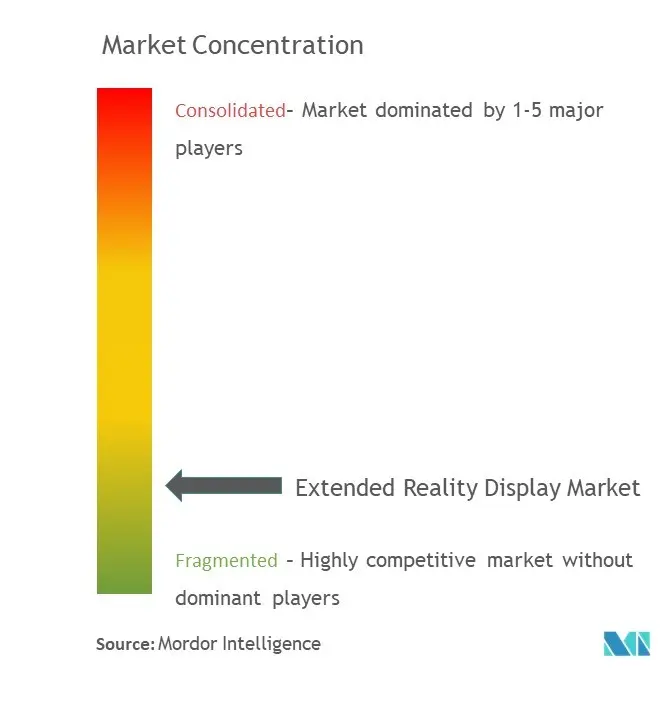
Extended Reality Display Market News
- July 2022 - Kopin received production orders totaling approximately USD 3.8 million for its new ultra-bright, full-color Brillian Active Matrix Liquid Crystal Display (AMLCD) used by helicopter pilots to display real-time flight and target information. The current orders have scheduled deliveries through the fourth quarter of 2023.
- July 2022 - Samsung Display will be developing a MicroOLED panel for its customers, including Samsung Electronics, Apple, and Meta.
- June 2022 - JDI developed its revolutionary transparent Raelclear display technology and planned to mass manufacture a new 20.8-inch Rælclear display with 2X brightness in the fall of 2023. This new 20.8-inch display was designed and developed to meet consumer needs for more and richer information on a single display. JDI used its proprietary backplane technology to 2X the refresh rate, decrease flicker, and boost image clarity, along with the large 20.8-inch screen.
Extended Reality Display Market Report - Table of Contents
1. INTRODUCTION
- 1.1 Study Assumptions and Market Definition
- 1.2 Scope of the Study
2. RESEARCH METHODOLOGY
3. EXECUTIVE SUMMARY
4. MARKET INSIGHTS
- 4.1 Market Overview
-
4.2 Industry Attractiveness - Porter's Five Forces Analysis
- 4.2.1 Bargaining Power of Suppliers
- 4.2.2 Bargaining Power of Buyers
- 4.2.3 Threat of New Entrants
- 4.2.4 Intensity of Competitive Rivalry
- 4.2.5 Threat of Substitutes
-
4.3 Technology Snapshot
- 4.3.1 Virtual Reality
- 4.3.2 Augmented Reality
- 4.3.3 Mixed Reality
- 4.4 Assessment on the impact due to COVID-19 on the market
5. MARKET DYNAMICS
-
5.1 Market Drivers
- 5.1.1 Rising Adoption of AR and VR Applications Across Multiple End-user Industries
- 5.1.2 Significant Technological Advancement Across Micros Displays Such as MicroLEDs
-
5.2 Market Restraints
- 5.2.1 Complex Manufacturing Process Involved for the Production of Displays
- 5.2.2 Limited Content Available for the Extended Reality Wearables
6. MARKET SEGMENTATION
-
6.1 By Display Type
- 6.1.1 Liquid Crystal Displays (LCD)
- 6.1.2 Organic Light-Emitting Diode (OLED)
- 6.1.3 Other Display Type
-
6.2 By End-User Industry
- 6.2.1 Gaming and Entertainment
- 6.2.2 Healthcare
- 6.2.3 Education
- 6.2.4 Military and Defense
- 6.2.5 Automotive and Manufacturing
- 6.2.6 Retail
- 6.2.7 Other Applications
-
6.3 By Geography
- 6.3.1 North America
- 6.3.2 Europe
- 6.3.3 Asia Pacific
- 6.3.4 Rest of the World
7. COMPETITIVE LANDSCAPE
-
7.1 Company Profiles
- 7.1.1 Sony Corporation
- 7.1.2 Samsung Electronics Co., Ltd.
- 7.1.3 Kopin Corporation
- 7.1.4 Japan Display Inc.
- 7.1.5 Plessey Company plc
- 7.1.6 eMagin Corporation
- 7.1.7 LG Display Co., Ltd.
- 7.1.8 Lumus, Ltd.
- 7.1.9 Seiko Epson Corporation
- 7.1.10 BOE Technology Group Co., Ltd.
- 7.1.11 Realfiction Holding AB
- 7.1.12 SA Photonics, Inc.
- *List Not Exhaustive
8. INVESTMENT ANALYSIS
9. MARKET OPPORTUNITIES AND FUTURE TRENDS
Extended Reality Display Industry Segmentation
Extended Reality (XR) is the collective term used for Virtual Reality (VR), Augmented Reality (AR), and Mixed Reality (MR), as well as all future realities such as technology, might bring. XR covers the full spectrum of real and virtual environments. Extended reality displays include Liquid Crystal Displays, Organic Light-Emitting Diode, Digital Light Projector Microdisplay, and Liquid Crystal on Silicon Microdisplay, among others.
The Extended Reality Display Market is segmented by Display Type (Liquid Crystal Displays, Organic Light-Emitting Diode), End-User Industry (Gaming and Entertainment, Healthcare, Education, Military and Defense, Automotive and Manufacturing, Retail), and Geography.
| By Display Type | Liquid Crystal Displays (LCD) |
| Organic Light-Emitting Diode (OLED) | |
| Other Display Type | |
| By End-User Industry | Gaming and Entertainment |
| Healthcare | |
| Education | |
| Military and Defense | |
| Automotive and Manufacturing | |
| Retail | |
| Other Applications | |
| By Geography | North America |
| Europe | |
| Asia Pacific | |
| Rest of the World |
Extended Reality Display Market Research FAQs
How big is the Extended Reality Display Market?
The Extended Reality Display Market size is expected to reach USD 2.82 billion in 2025 and grow at a CAGR of 46.06% to reach USD 18.74 billion by 2030.
What is the current Extended Reality Display Market size?
In 2025, the Extended Reality Display Market size is expected to reach USD 2.82 billion.
Who are the key players in Extended Reality Display Market?
Sony Corporation, Samsung Electronics Co., Ltd., Kopin Corporation, Japan Display, Inc. and Lumus, Ltd. are the major companies operating in the Extended Reality Display Market.
Which is the fastest growing region in Extended Reality Display Market?
Asia Pacific is estimated to grow at the highest CAGR over the forecast period (2025-2030).
Which region has the biggest share in Extended Reality Display Market?
In 2025, the North America accounts for the largest market share in Extended Reality Display Market.
What years does this Extended Reality Display Market cover, and what was the market size in 2024?
In 2024, the Extended Reality Display Market size was estimated at USD 1.52 billion. The report covers the Extended Reality Display Market historical market size for years: 2019, 2020, 2021, 2022, 2023 and 2024. The report also forecasts the Extended Reality Display Market size for years: 2025, 2026, 2027, 2028, 2029 and 2030.
Our Best Selling Reports
Extended Reality Display Market Research
Mordor Intelligence provides a comprehensive analysis of the XR display industry. This includes crucial technologies such as AR display, VR display, and MR display solutions. Our extensive research covers emerging technologies like holographic display, transparent display, and interactive display systems. Additionally, we explore cutting-edge microdisplay technologies that power next-generation devices. The report offers detailed insights into wearable display technologies, including innovations in smart glasses display and advancements in optical display that are transforming the metaverse display landscape.
Stakeholders gain valuable insights through our detailed examination of immersive display technologies and their applications across various sectors. The report, available as an easy-to-download PDF, presents an in-depth analysis of the 3D display market dynamics and emerging trends in the microdisplay market. Our comprehensive coverage extends to the holographic display market, transparent display market, and interactive display market. This provides stakeholders with actionable intelligence for strategic decision-making. The analysis includes a detailed examination of the wearable display market and holographic display industry, supported by extensive primary research and data-driven insights.




